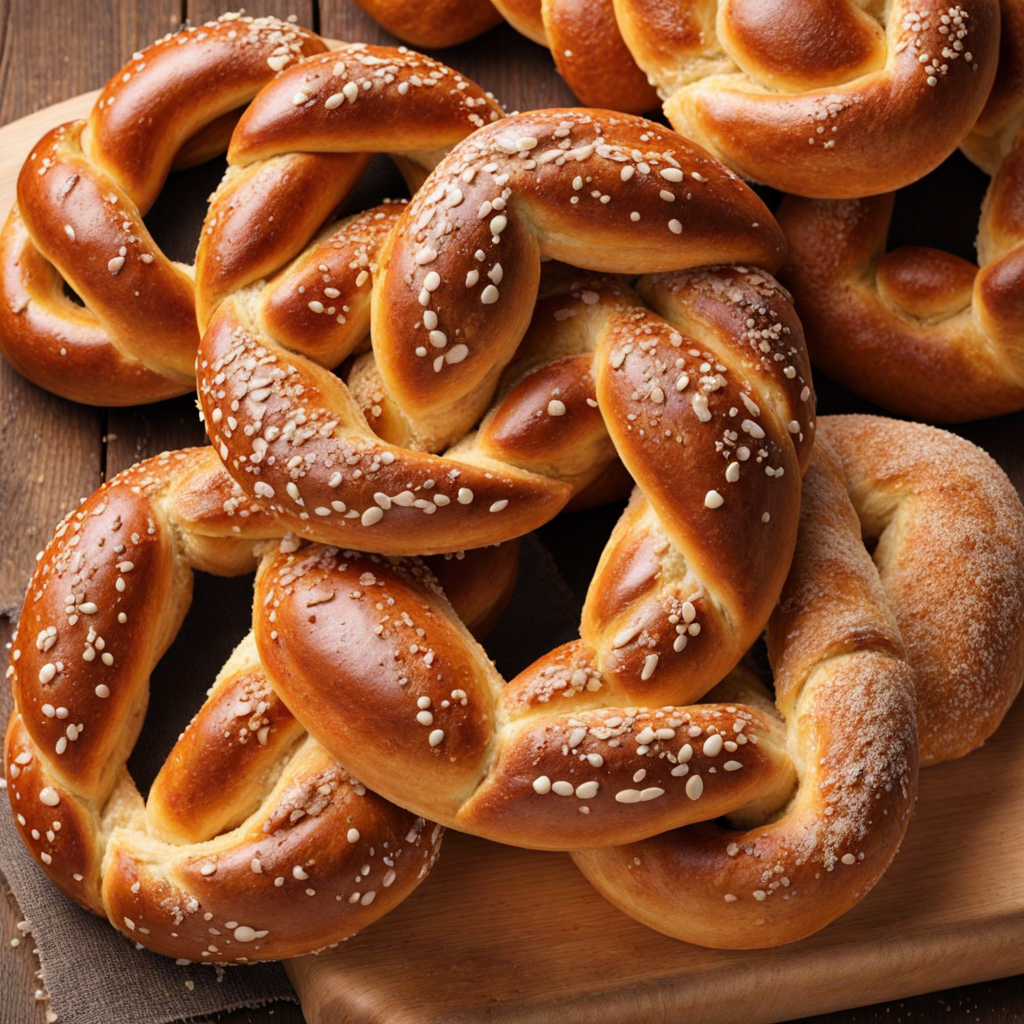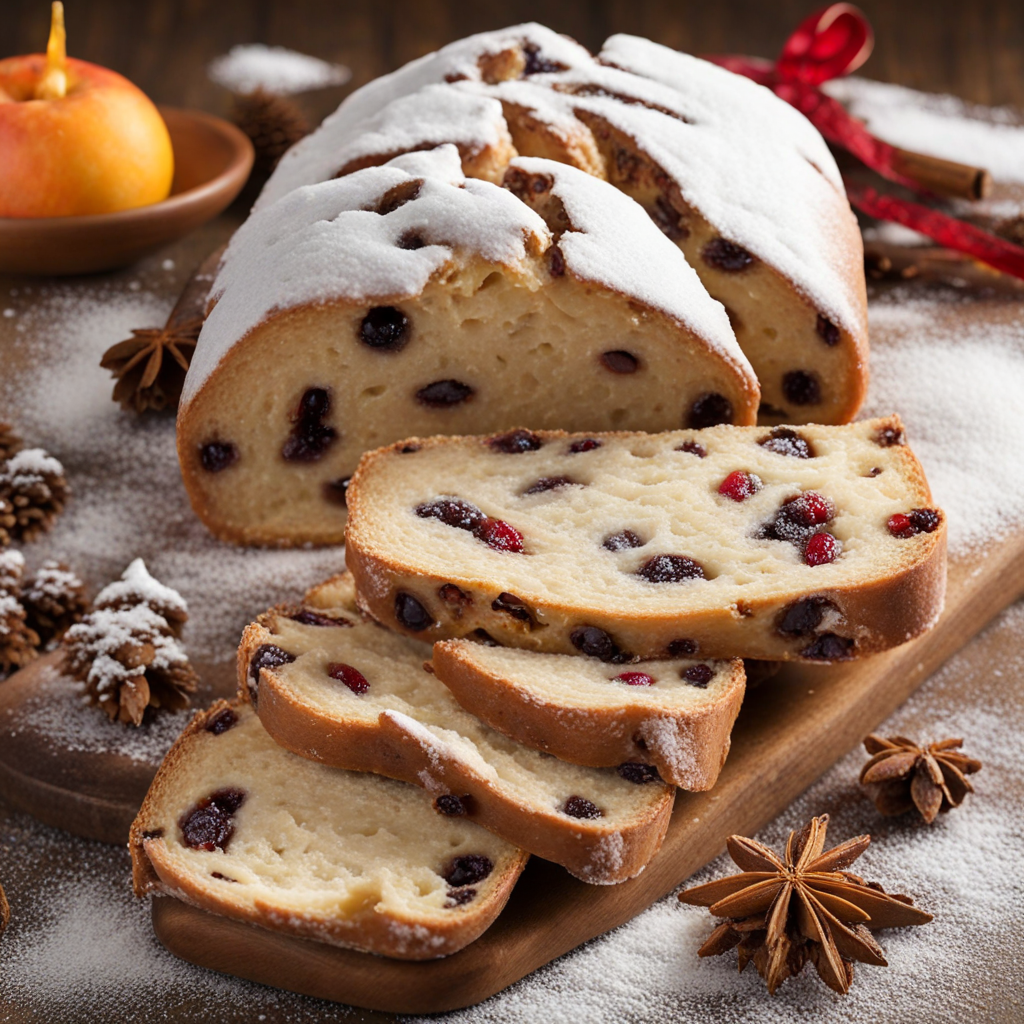Pretzel
Pretzels, originating from Germany, are a delightful twist on traditional bread, characterized by their unique shape and flavor. Shaped like a knot, these baked treats have a glossy, dark brown exterior that results from a special boiling process in a baking soda solution before they are baked. This technique not only imparts a distinctive color but also contributes to their chewy texture, making every bite a satisfying experience. The outer crust is crispy and slightly salty, providing a perfect contrast to the soft, pillowy interior that is subtly flavored with hints of yeast and malt. The flavor profile of pretzels is versatile, making them a popular snack that can be enjoyed on their own or paired with various dips and toppings. Traditional German pretzels are often sprinkled with coarse salt, enhancing their savory appeal. However, they can also be adorned with a variety of seasonings, such as sesame seeds or cheese, to cater to diverse palates. This adaptability allows pretzels to be served in different contexts – from street food vendors offering warm, fresh pretzels with mustard to upscale dining experiences featuring pretzel bread served alongside gourmet dishes. Pretzels hold a special place in German culture, often enjoyed during festivals, Oktoberfest, and family gatherings. They embody a sense of community and celebration, as sharing a large pretzel can evoke feelings of togetherness. Whether you’re munching on a classic pretzel or trying a creative twist like a cinnamon sugar pretzel for dessert, you’ll discover a delightful new taste that reflects the rich culinary heritage of Germany. Each bite invites you to explore the warmth and history of this beloved food, making it a truly unique experience for any food enthusiast.
How It Became This Dish
The History of Brezel: Germany’s Iconic Pretzel #### Origin of Brezel The Brezel, or pretzel, is a quintessential symbol of German culinary heritage, with a history that dates back over a thousand years. Its origins are shrouded in legend and folklore, but the earliest known references to a bread shaped like a pretzel can be traced to the early Middle Ages. One popular tale suggests that the pretzel was invented by an Italian monk in the 7th century, who made the dough into the shape of a child’s arms crossed in prayer. This shape, resembling a figure in prayer, was said to symbolize the reward of eternal life, and the three holes represented the Holy Trinity. The first documented mention of the pretzel comes from a German manuscript dating back to 1111. In this document, a baker in the Swabian region was granted a privilege for selling "bracellae," a term believed to be derived from the Latin word "brachiola," meaning "little arms." This early reference indicates that the pretzel was not only a food item but also a significant part of the local culture, highlighting the intertwined nature of food and tradition in medieval Europe. #### Cultural Significance The Brezel holds a special place in German culture and is much more than a simple snack or bread; it is a symbol of hospitality, celebration, and community. In many parts of Germany, pretzels are an essential component of festivities and gatherings. During Oktoberfest and other beer festivals, pretzels are often enjoyed alongside hearty sausages and beer, embodying the spirit of conviviality and togetherness. Traditionally, pretzels have been associated with various customs and rituals. For instance, in southern Germany, pretzels are often given as gifts at weddings, symbolizing good fortune and prosperity for the newlyweds. The act of sharing a Brezel is also a gesture of friendship and goodwill, with the soft, salty bread serving as a unifying element in social interactions. Moreover, the pretzel’s distinctive shape has lent itself to various interpretations. The loops and twists are said to represent a bond between the baker and the community, reinforcing the importance of craftsmanship and local traditions. In some regions, the pretzel is even regarded as a protective charm, believed to ward off evil spirits and bring good luck. #### Development Over Time The evolution of the Brezel has been influenced by various factors, including regional variations, technological advancements, and cultural exchanges. As the popularity of pretzels spread throughout Europe, different regions began to develop their own interpretations. While the classic soft pretzel is a staple in Germany, variations can be found across the continent, from the crunchy, thin pretzels of Bavaria to the softer, fluffier versions popular in the Rhineland. In the 19th century, the pretzel became a staple of German bakeries, with bakers refining their techniques to create the perfect Brezel. This period saw the introduction of lye (sodium hydroxide) as a crucial ingredient in the boiling process, which gives pretzels their characteristic dark brown crust and distinctive flavor. The use of lye was a game-changer, allowing bakers to produce a pretzel that was not only visually appealing but also texturally unique, with a satisfying chewiness that has become emblematic of the Brezel. As German immigrants began to settle in the United States in the 18th and 19th centuries, they brought their culinary traditions with them, including the beloved pretzel. In cities with large German populations, such as Philadelphia and Cincinnati, pretzel bakeries began to emerge, adapting the recipe to suit local tastes. The American pretzel often emphasized a crunchier texture and was sometimes seasoned with additional toppings, such as cheese or garlic, catering to a different palate while still honoring the original German recipe. In the 20th century, as the world became more interconnected, the pretzel began to gain international fame. The rise of mass production and the invention of pretzel-making machines allowed for increased accessibility, leading to the snack's widespread availability in supermarkets and convenience stores. The soft pretzel gained particular popularity in the U.S., becoming a staple at sporting events and street fairs, where vendors would sell them hot and fresh, often accompanied by mustard or cheese sauce. #### Modern Interpretations Today, the Brezel continues to evolve, adapting to contemporary culinary trends and dietary preferences. Artisanal bakeries are experimenting with unique flavors and ingredients, incorporating whole grains, seeds, and even gluten-free options to cater to a broader audience. Gourmet versions of the pretzel, such as those topped with exotic spices or served with innovative dips, are increasingly common, reflecting a blend of traditional craftsmanship and modern culinary creativity. In Germany, the pretzel remains an enduring symbol of national identity. It is celebrated in various food festivals, and its image can be found on everything from souvenirs to beer labels, reinforcing its status as a cultural icon. The “Pretzel Day” in the U.S., held on April 26, celebrates the snack’s popularity and recognizes its German roots, showcasing the global reach of this simple yet beloved food. #### Conclusion The Brezel is more than just a delicious snack; it is a testament to centuries of cultural heritage, tradition, and community. From its mythical origins to its place in modern cuisine, the pretzel has transcended borders and generations, evolving while maintaining its core identity. As we savor this delightful bread, we partake in a rich history that connects us to the past and to one another, celebrating the enduring allure of the Brezel in the tapestry of global gastronomy. Whether enjoyed at a family gathering, a festive celebration, or a casual day out, the pretzel embodies a shared experience that continues to resonate across cultures and time.
You may like
Discover local flavors from Germany







